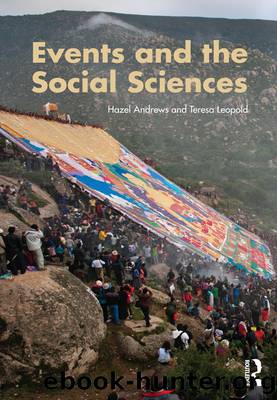Events and the Social Sciences by Andrews Hazel;Leopold Teresa;

Author:Andrews, Hazel;Leopold, Teresa;
Language: eng
Format: epub
ISBN: 1125159
Publisher: Taylor & Francis Group
(Source: Hagström 2007)
It is these meanings that link consumption practices with the reproduction of identity and social relations. Before we connect consumption choices to these two areas of social life we need to consider the issue of commodification.
Commodification
Kevin Meethan (2001: 5) sums up the meaning of commodification quite nicely when he states it is âthe ways in which material culture, people and places become objectified for the purposes of the global marketâ. What Meethan is referring to is the ways by which things, people and places become commodities. A commodity is an item that has had a price attached to it and can be bought and sold. Thus the food we buy, our clothes and our household items â fridges, TVs, furniture and so on â are all commodities. Turning things into commodities is part of consumer cultures so that, within the context of events, we can see many cultural festivals and rituals being repackaged as commodities. One example is when Pope Benedict visited Bavaria in 2006.This religious event was commodified, with a huge range of merchandise and goods available to celebrate the event ranging from âPapst-Bierâ (pope beer) to Vatican flags, mugs and beer glasses with pictures of the Pope, and specific websites dedicated to promoting the visit. Another example can be seen in Figure 5.3, which shows a café advertising food as part of the Queen's Jubilee celebrations in the UK in 2012.
Turning things into commodities does not only refer to the actual cultural goods that are produced and consumed, such as songs, food and dances, but also to experiences. Indeed, experiencing festivals and cultural events, and even the âfantasy of an imagined and desired experienceâ of an event, presents a commodity (Green 2007: 205).
What needs to be remembered within this context is that when events become objectified and commodified, there is the need to differentiate one event from the other. Thus, many commodified events (such as the Trinidad Carnival (Green 2007)) represent certain cultural elements while disregarding others, so that the authenticity of such events may get lost (this will be explored in more detail below). Such a commodification process might impact on local and regional relationships, and local and personal identities. A different viewpoint is presented by Phipps (2011: 120), in his work on an Indigenous cultural festival in Australia. While acknowledging the danger of commodification of cultural elements, he argues that: âcultural festivals at very least provide opportunities for direct encounters with Indigenous people that can counteract some of the routine colonising practicesâ. In other words, the consumption and commodification of indigenous values, customs, games, music and dances presents the possibility for âserious, joyful and urgent acts of cultural politicsâ.
In terms of events, we can see that many festivals and rituals that were once of local interest become part of the package of entertainment for tourists, something the tourists pay to see, either indirectly because they have bought a holiday at a particular destination in which an event is held, or directly by paying, where required, either to participate in or view such events.
Download
This site does not store any files on its server. We only index and link to content provided by other sites. Please contact the content providers to delete copyright contents if any and email us, we'll remove relevant links or contents immediately.
Life 3.0: Being Human in the Age of Artificial Intelligence by Tegmark Max(5198)
The Sports Rules Book by Human Kinetics(4081)
The Age of Surveillance Capitalism by Shoshana Zuboff(3999)
ACT Math For Dummies by Zegarelli Mark(3858)
Blood, Sweat, and Pixels by Jason Schreier(3500)
Unlabel: Selling You Without Selling Out by Marc Ecko(3477)
Hidden Persuasion: 33 psychological influence techniques in advertising by Marc Andrews & Matthijs van Leeuwen & Rick van Baaren(3306)
Urban Outlaw by Magnus Walker(3250)
The Pixar Touch by David A. Price(3225)
Bad Pharma by Ben Goldacre(3107)
Project Animal Farm: An Accidental Journey into the Secret World of Farming and the Truth About Our Food by Sonia Faruqi(3027)
Brotopia by Emily Chang(2902)
Kitchen confidential by Anthony Bourdain(2837)
Slugfest by Reed Tucker(2809)
The Content Trap by Bharat Anand(2784)
The Airbnb Story by Leigh Gallagher(2711)
Coffee for One by KJ Fallon(2433)
Smuggler's Cove: Exotic Cocktails, Rum, and the Cult of Tiki by Martin Cate & Rebecca Cate(2343)
Beer is proof God loves us by Charles W. Bamforth(2255)
